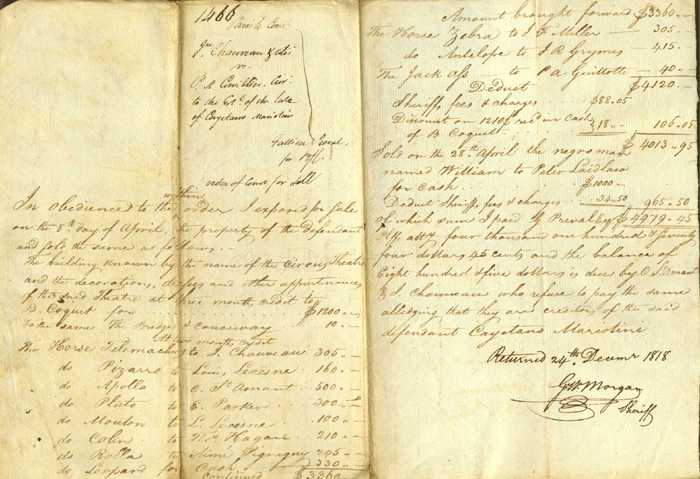
A record of the property sold at a court-ordered sheriff's sale to settle a debt
of more than $10,000 left by the late Cayetano Mariotini, 1818.
Cayetano Mariotini, a Cuban, began to bring his circus to New Orleans in the early
1800s. He set up his tents on South Rampart Street in "Circus Square" -- better known
by its current name, Congo Square -- where he and his wife entertained New
Orleanians with equestrian acts. Cayetano's circus became an institution in the early
city and even inspired a song sung in Creole patois. In 1816, Cayetano built the
Olympia Theater, adjoining his circus, but the new venture was not a success, and he
soon found himself so badly in debt that he had to sign over his ten horses, a jackass,
and his slave William to his creditors as security. When he died in October 1818, his
debts still unpaid, the creditors brought suit against his estate, asking that the property
he had signed over to them be sold. Thus, Cayetano's circus horses went on the block.
The ire of the Governor had been
thoroughly aroused by one of the most flagrant of all the rowdy exploits of the flatboat
crews--an attack upon Gaetano's Circus, which had been showing in New Orleans so
long--apparently it first appeared in the city soon after the American occupation--that it
had become almost an institution. Its many wonders were celebrated in a song, of
innumerable verses, which the Negroes sang on the streets and in the market-places.
It began:
'Tis Monsieur Gaetano
Who comes out from Havana
With his horses and his monkeys!
He has a man who dances in a sack;
He has one who dances on his hands;
He has another who drinks wine on horseback;
He has also a pretty young lady
Who rides a horse without bridle or saddle.
To tell you all about it I am not able--
But I remember one who swallowed a sword.
. . . .